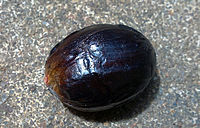


| |

| |

| |
| Names | |
|---|---|
| Systematic IUPAC name
Propane-1,2,3-triyl tri(tetradecanoate) | |
| Other names
Glyceryl trimyristate; Glycerol tritetradecanoate;[2] 1,2,3-Tritetradecanoylglycerol[3] | |
| Identifiers | |
| |
3D model (JSmol) |
|
| ChemSpider |
|
| ECHA InfoCard | 100.008.273 |
| EC Number |
|
PubChem CID |
|
| UNII | |
CompTox Dashboard (EPA) |
|
| |
| |
| Properties | |
| C45H86O6 | |
| Molar mass | 723.177 g·mol−1 |
| Appearance | White-yellowish gray solid |
| Odor | Odorless |
| Density | 0.862 g/cm3 (20 °C)[4] 0.8848 g/cm3 (60 °C)[2] |
| Melting point | 56–57 °C (133–135 °F; 329–330 K) at 760 mmHg[2][4][5] |
| Boiling point | 311 °C (592 °F; 584 K) at 760 mmHg[2] |
| Solubility | Slightly soluble in alcohol, ligroin Soluble in diethyl ether, acetone, benzene,[2] dichloromethane, chloroform, TBME |
Refractive index (nD) |
1.4428 (60 °C)[2] |
| Structure | |
| Triclinic (β-form)[3] | |
| P1 (β-form)[3] | |
a = 12.0626 Å, b = 41.714 Å, c = 5.4588 Å (β-form)[3] α = 73.888°, β = 100.408°, γ = 118.274° | |
| Thermochemistry | |
Heat capacity (C) |
1013.6 J/mol·K (β-form, 261.9 K) 1555.2 J/mol·K (331.5 K)[5][6] |
Std molar |
1246 J/mol·K (liquid)[6] |
Std enthalpy of |
−2355 kJ/mol[6] |
Std enthalpy of |
27643.7 kJ/mol[6] |
| Hazards | |
| NFPA 704 (fire diamond) | |
| Flash point | > 110 °C (230 °F; 383 K)[7] |
| 421.1 °C (790.0 °F; 694.2 K)[7] | |
Except where otherwise noted, data are given for materials in their standard state (at 25 °C [77 °F], 100 kPa). | |
Trimyristin is a saturated fat and the triglycerideofmyristic acid with the chemical formulaC45H86O6. Trimyristin is a white to yellowish-gray solid that is insoluble in water, but soluble in ethanol, acetone, benzene, chloroform, dichloromethane, ether, and TBME.
Trimyristin is found naturally in many vegetable fats and oils.

The isolation of trimyristin from powdered nutmeg is a common introductory-level college organic chemistry experiment.[8][9] It is an uncommonly simple natural product extraction because nutmeg oil generally consists of over eighty percent trimyristin. Trimyristin makes up between 20-25% of the overall mass of dried, ground nutmeg. Separation is generally carried out by steam distillation and purification uses extraction from ether followed by distillation or rotary evaporation to remove the volatile solvent. The extraction of trimyristin can also be done with diethyl ether at room temperature, due to its high solubility in the ether. The experiment is frequently included in curricula, both for its relative ease and to provide instruction in these techniques. Trimyristin can then be used to prepare myristic acid[10] or one of its salts[11] as an example of saponification.
|
Types of lipids
| |
|---|---|
| General |
|
| Geometry |
|
| Eicosanoids |
|
| Fatty acids |
|
| Glycerides |
|
| Phospholipids |
|
| Sphingolipids |
|
| Steroids |
|
This biochemistry article is a stub. You can help Wikipedia by expanding it. |